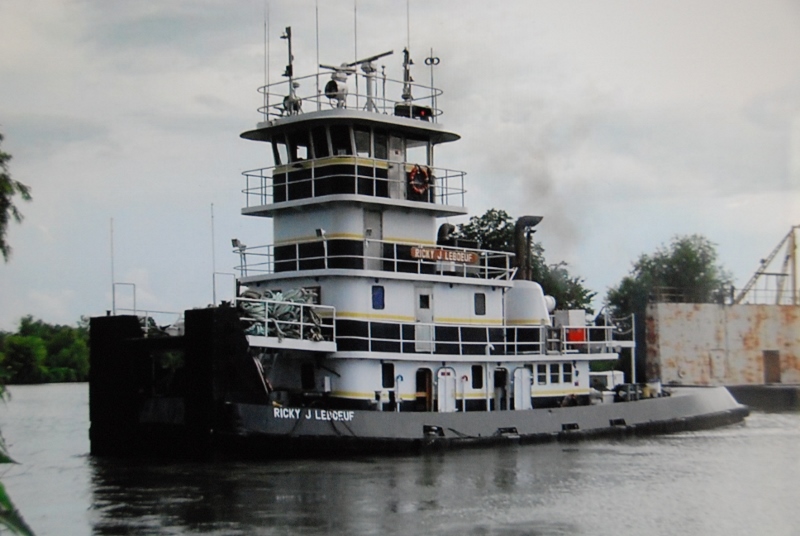An April 2016 towboat capsize that killed a crewman in Texas was the result of a failed downstreaming maneuver, similar to a 2015 fatal accident in Louisiana, according to a new National Transportation Safety Board report.
The 67’x24’x8’, 1,800 hp Ricky J Leboeuf , owned by D & S Marine Service and operated by Kirby Inland Marine, was moving to pick up two empty tank barges on the San Jacinto River near Channelview, Texas, when the accident happened on the morning of April 19.
The San Jacinto river stage was 15’, a full 5’ above flood stage as a result of prolonged heavy spring rains across that region of Texas, topped off by 5.17” of rainfall in the river basin itself the day before, according to National Oceanic and Atmospheric Administration data.
The Coast Guard Vessel Traffic Service for Houston/Galveston had issued advisory warnings of high water and fast currents. Kirby had issued advisories via email to its towboat crews about restrictions on downstreaming maneuvers — going with the flow of the current, using engines astern to slow the towboat until making contact with a barge. The company also reminded crews about the use of assist towboats, and the need to close main deck watertight doors and hatches in accordance with the company’s safety management system, NTSB investigators found.
The Ricky J Leboeuf was dispatched at 7:15 a.m. from its mooring at the CEMEX facility near Channelview, with instructions to pick up the barges from Kirby’s nearby fleeting area and proceed with them to Beaumont, Texas.
With a crew of five, the towboat relief captain, credentialed as a towing master for unlimited tonnage in domestic waters and with 12 years experience, was in charge of the watch. The junior tankerman/steersman was at the helm, the deckhand preparing to take the barges under tow, while the captain and senior tankerman were off watch in their staterooms, according to the report.
The crew proceeded 2.6 miles from Old River, through the Houston Ship Canal, and into the San Jacinto River. According to Automatic Information System (AIS) data, the towboat’s speed over ground was 6.4 knots in the Houston Ship Channel, but quickly dropped to 3.5 knots as it pushed into the San Jacinto with its fast current.
The junior tankerman told investigators how he and the relief captain noticed the effect of the current. When they arrived at the fleeting area at 7:46 a.m., the Ricky J Leboeuf was making 4 knots.
“The relief captain expressed concern regarding the stronger-than-average current and, given the prevailing conditions, took control of the vessel from the junior tankerman/steersman because he wanted to demonstrate the proper way of performing the downstreaming maneuver,” the report states.
The relief captain took the Ricky J Leboeuf upstream of the barges. At 7:48 a.m. he turned to port to start the downstream move, approaching the barge fleet at 1.6 knots. Two minutes later the towboat’s port push knee made contact.
“Using the two main diesel engines, the rudders, and the flanking rudders, the relief captain attempted to pivot the vessel to square it up on the barge. However, his efforts were unsuccessful,” the report states. The current was moving at an angle relative to the barge and began pushing on the starboard side of the towboat as its port side fendered against several barges. At 7:53 the vessel heeled to starboard, taking on water through two open doors, as the relief captain sounded the general alarm.
Both the captain and senior tankerman escaped from their staterooms, as the relief captain and junior tankerman made their way to safety. The deckhand was last seen trying to swim; his body was recovered by a search and rescue team around 10 a.m., without the safety work vest he had been wearing on deck.
The towboat was a total constructive loss at $900,000 and some 10,400 gals. of fuel, lubricant, and other fluids leaked into the river.
The relief captain refused to be interviewed by Coast Guard and NTSB investigators, the report said. It noted that under Kirby company policy, he should have consulted with the captain or Kirby’s port captain before attempting the downstreaming maneuver.
“The National Transportation Safety Board determines that the probable cause of the capsizing and sinking of the towing vessel Ricky J Leboeuf was the relief captain’s ill-advised decision to perform a downstreaming maneuver in high water conditions without implementing the operating company’s risk mitigation strategies or other safeguards,” the NTSB investigators concluded.
The NTSB report makes note of parallels to the Miss Natalie case, when the 59’x28’6”x7’7”, 1,600-hp fleeting towboat operated by Western Rivers Boat Management was pinned against the bow of a coal barge, rolled over and sank near Convent, La., on May 30, 2015. One of its four crew members drowned.
In both reports on the Miss Natalie and the Ricky J Leboeuf, the NTSB stressed findings from a nearly 20-year-old joint Coast Guard-American Waterways Operators study of downstreaming maneuvers and their risks.
Recommendations from that analysis include:
- Recognizing risks involved in downstreaming under high current conditions and be prepared to abort the maneuver if necessary.
- Make sure doors and windows on the first deck are closed and secured.
- Ensure that the vessel has adequate freeboard aft.
- Notify crewmembers of intentions.
- Position crewmembers to climb to safety in the event of a downstreaming casualty.
For towing companies, the study called for company policies that:
- Stress the need for safe operations during periods of high water, to include raising awareness as to the risks of downstreaming.
- Conduct daily crew meetings and communications at watch changes to identify and discuss downstreaming “close calls.”
- In advance of high water conditions, work with vessel operators to determine whether downstreaming should be prohibited at specific river stages.
- Institute high water procedures to address the need to close and secure doors and windows on the first deck.




